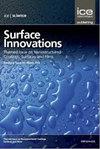Effect of Multi-walled carbon nanotube incorporation on the photocatalytic activity of TiO2 nanotubes
IF 3.5
4区 材料科学
Q3 CHEMISTRY, PHYSICAL
引用次数: 0
Abstract
Arrays of titanium dioxide (TiO 2 ) nanotubes were prepared on commercially pure titanium (Cp-Ti) foils by anodic oxidation in 0.5 M HF-based electrolyte with multi-walled carbon nanotubes (MWCNTs) addition up to 0.035 g/L. The samples were annealed at 450 °C for 1 h after the anodic oxidation to form a crystalline anatase structure. The effect of the MWCNTs addition on morphology and photocatalytic activity of the nanostructures was characterized by scanning electron microscopy (SEM), Raman spectroscopy, UV-Vis diffuse reflectance spectroscopy (DRS), photoluminescence (PL) spectroscopy, and methylene blue (MB) degradation tests. The results showed that MWCNTs were successfully incorporated into the TiO 2 nanotube structure, and significantly affected its photocatalytic activity. The best photocatalytic performance was achieved with the use of 0.025 g/L MWCNTs in the electrolyte composition. However, when the MWCNTs content in the electrolyte increased, the electron-hole recombination rate and photon absorption ability of the structure deteriorate, resulting in a decreased photocatalytic activity.多壁碳纳米管掺入对TiO2纳米管光催化活性的影响
采用添加量为0.035 g/L的多壁碳纳米管(MWCNTs)在0.5 M hf基电解质中阳极氧化的方法,在工业纯钛(Cp-Ti)箔上制备了二氧化钛(tio2)纳米管阵列。样品经阳极氧化后,在450℃下退火1 h,形成结晶锐钛矿结构。通过扫描电镜(SEM)、拉曼光谱(Raman spectroscopy)、紫外-可见漫反射光谱(DRS)、光致发光光谱(PL)和亚甲基蓝(MB)降解测试表征了添加MWCNTs对纳米结构形貌和光催化活性的影响。结果表明,MWCNTs成功地掺入到tio2纳米管结构中,并显著影响了其光催化活性。在电解质组合物中加入0.025 g/L的MWCNTs时,光催化性能最佳。然而,当电解质中MWCNTs含量增加时,结构的电子-空穴复合速率和光子吸收能力变差,导致光催化活性下降。
本文章由计算机程序翻译,如有差异,请以英文原文为准。
求助全文
约1分钟内获得全文
求助全文
来源期刊

Surface Innovations
CHEMISTRY, PHYSICALMATERIALS SCIENCE, COAT-MATERIALS SCIENCE, COATINGS & FILMS
CiteScore
5.80
自引率
22.90%
发文量
66
期刊介绍:
The material innovations on surfaces, combined with understanding and manipulation of physics and chemistry of functional surfaces and coatings, have exploded in the past decade at an incredibly rapid pace.
Superhydrophobicity, superhydrophlicity, self-cleaning, self-healing, anti-fouling, anti-bacterial, etc., have become important fundamental topics of surface science research community driven by curiosity of physics, chemistry, and biology of interaction phenomenon at surfaces and their enormous potential in practical applications. Materials having controlled-functionality surfaces and coatings are important to the manufacturing of new products for environmental control, liquid manipulation, nanotechnological advances, biomedical engineering, pharmacy, biotechnology, and many others, and are part of the most promising technological innovations of the twenty-first century.
 求助内容:
求助内容: 应助结果提醒方式:
应助结果提醒方式:


